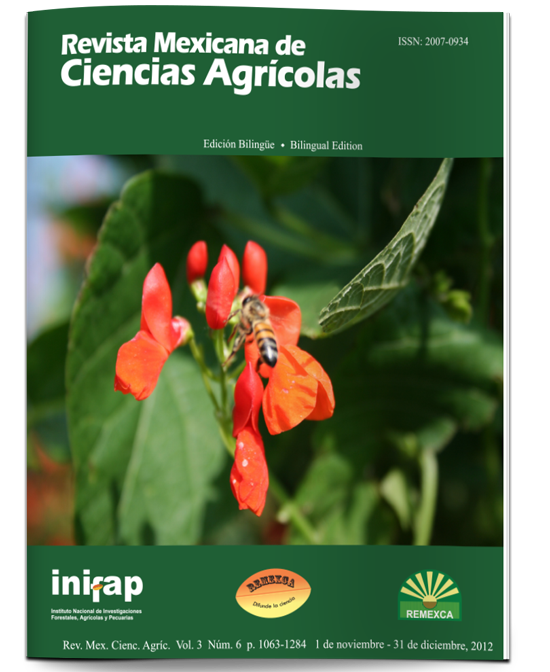Organic substrates in the production of sweet pepper
DOI:
https://doi.org/10.29312/remexca.v3i6.1372Keywords:
Capsicum annum L., ammonium, green house, nitratesAbstract
The present work pretends to give information about the use of organic substrates made from bovine manure treated for the production of sweet peppers. The research was made in a green house from 2010-2011 at the Instituto Tecnológico de Torreon (ITT), in Torreon, Coahuila. It was randomized blocks design; considering four treatments with then replications: T1= VermicompostA + Sand; T2= Biocompost + Sand; T3= VermicompostB + Sand and T4= Sand (check; Steiner solution). The substrates mixtures were formulated based on volume, keeping a proportion of 1:1 (v/v), using black polyethylene bags of 10 Kg weight. The genetic material used was the hybrid Calider of yellow fruit blocky type; the experiment was established en 2010-2011. The evaluated variables were plant height, yield and fruit quality, soluble solids, pH, EC, OM, nitrates and ammonium. The results showed a significant response, emphasizing on EC, pH, OM, nitrates, ammonium and yield; being the check treatment with the higher yield (6.93 kg mg-2), followed by vermicompost2 (5.24 kg m-2) and vermicompostA (4.95 kg m-2). The content of nitrates was higher in Biocompost with 540.51 mg Kg-1, followed by vermicompostB with 350.47 mg Kg-1. However the evaluated organic substrates showed an ideal chemical characteristic of a good substrate; low CE, high content of MO, pH between 7 and 8; a high content of nitrates and ammonium.
Downloads
Downloads
Published
How to Cite
Issue
Section
License
The authors who publish in Revista Mexicana de Ciencias Agrícolas accept the following conditions:
In accordance with copyright laws, Revista Mexicana de Ciencias Agrícolas recognizes and respects the authors’ moral right and ownership of property rights which will be transferred to the journal for dissemination in open access. Invariably, all the authors have to sign a letter of transfer of property rights and of originality of the article to Instituto Nacional de Investigaciones Forestales, Agrícolas y Pecuarias (INIFAP) [National Institute of Forestry, Agricultural and Livestock Research]. The author(s) must pay a fee for the reception of articles before proceeding to editorial review.
All the texts published by Revista Mexicana de Ciencias Agrícolas —with no exception— are distributed under a Creative Commons License Attribution-NonCommercial 4.0 International (CC BY-NC 4.0), which allows third parties to use the publication as long as the work’s authorship and its first publication in this journal are mentioned.
The author(s) can enter into independent and additional contractual agreements for the nonexclusive distribution of the version of the article published in Revista Mexicana de Ciencias Agrícolas (for example include it into an institutional repository or publish it in a book) as long as it is clearly and explicitly indicated that the work was published for the first time in Revista Mexicana de Ciencias Agrícolas.
For all the above, the authors shall send the Letter-transfer of Property Rights for the first publication duly filled in and signed by the author(s). This form must be sent as a PDF file to: revista_atm@yahoo.com.mx; cienciasagricola@inifap.gob.mx; remexca2017@gmail.
This work is licensed under a Creative Commons Attribution-Noncommercial 4.0 International license.



